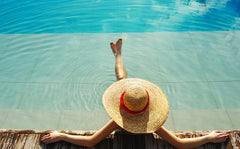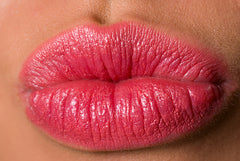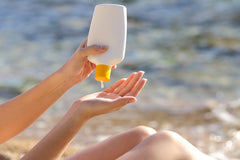Can I get athlete's foot from my yoga mat?

Southern Hospitality answers the question: Can I get athlete's foot from my yoga mat? Courtesy of YouBeauty!
Putting your best FEET forward,
SH
5 Ways to Keep Your Feet Infection-Free in Public Places

Whether you’ve made the trek off to college or have a knack for going barefoot in public facilities, there is no doubt that you will need to protect yourself from the dreaded staph infection. Not just any staph infection, but MRSA (Methicillin-resistant Staphylococcus aureus). Staph infections are spread through skin-to-skin contact. However, MRSA is a form of bacteria that is resistant to common antibiotics used to treat other forms of staph infections. Contact with MRSA can range from just a simple pimple on the skin to a severely invasive infection that can lead to amputation. College dorms, gyms, locker rooms, public pools and hospitals are all common breeding grounds for MRSA. Here are 5 ideas to follow to keep your feet infection-free!
Protect Open Wounds: Any cuts, wounds, or breaks in the skin give easy access for bacteria to invade your body and cause an infection. The solution? Make sure these areas are securely covered to prevent being infected. It is also great as an added precaution to inspect your feet regularly depending on how frequent you share public facilities.
Wash Socks After Use: The warmth and moisture from your feet absorbed by your socks can allow bacteria to fester. You should never where the same pair of socks for consecutive workouts. Instead, wash them after working out and sport a fresh clean pair for each workout.
Don’t Share Personal Items: Sharing is NOT caring in the case of MRSA. Personal items such as towels, razors, shoes, or even socks can bring you in direct contact with the bacteria. Even if another person’s item may appear to be clean, don’t trust it! You run the risk of not truly finding out until it is too late.
Putting your best FEET forward,
SH
Dx Beach Feet: 4 Ways to Heal Your Summer Heels

Summertime fun means sporting sandals or- in many cases- going barefoot, that exposes your feet to the harsh elements of the season. Check out these 4 tips that are just what the doctor ordered to heal your summer heels!
Wash
It’s just not enough to let the water and suds trickle down to your feet when showering and claim that they are clean. A barefoot day at the beach or a simple saunter in your favorite flip-flops can expose your feet to all sorts of yuck-n-muck. The solution? Take care to give your feet a thorough washing DAILY (that means rubbin’ and scrubbin’). Foot washing is like hand washing and should be done routinely. It is also a great idea to soak your feet with warm water and Epsom salt. Soaking your feet provides a one-two punch of deodorizing and drawing out toxins to keep them funk-free!
Inspect
Bacteria, Virus, and Fungus….oh my! Your feet can become infected with any of these “beauties” with any cuts or openings of the skin. Whether you have the displeasure of stepping on rocks, shells, or any foreign object openings of the skin can be dangerous- large and small. That’s why it is essential to regularly inspect your feet for any open wounds or lesions that may be present. Warts can indicate viruses (such as HPV), while redness, swelling, and/or itching can be signs of bacterial (E. coli) or fungal (Athlete’s foot) infections.
Exfoliate
Unforgiving surfaces such as hot sand and pavement can lead to a load of calluses on the feet. To transition your feet from rough to smooth, exfoliate the callused areas. Be careful to ALWAYS exfoliate WET skin- preferably when showering or soaking. Tools, such as pumice stones or foot files are most aggressive, but scrubs can also do the trick.
Moisturize
Once you remove the skin you don’t want, you always want to show a lil love to the skin you do want. And nothing says T-L-C like a rich moisturizer. A daily slather of moisturizer to clean feet smoothes the skin and provides nutrients to make your feet very supple. It’s the perfect finish to healing those summer heels!
Oh!...and as always, if you’re going to continue to be out in the sun… DON’T forget the sunscreen!!
Putting your best FEET forward,
SH
5 Areas You Don’t Want to Forget to Apply Sunscreen

So you think you’ve slathered on your sunscreen and are ready for a day of fun in the sun…but have you considered these areas? You better!
From HEAD…
Scalp: 
Whether you’re bald or have long luscious locks, an exposed scalp should not be taken lightly for sun protection. Even the smallest part in your (hair)do can reveal enough skin for the sun to do damage. Studies show that melanoma on the scalp can result in a faster rate of death than any other part of the body.
Ears: 
Arms, legs, and face…CHECK! But did you get your ears? They are the 3rd most common site for skin cancer from the sun and should NEVER go untouched. If sunscreen for your ears doesn’t tickle your fancy, try a nice hat with a wide brim to shield you from the sun.
Lips: 
Did you miss a spot with your sunscreen, but can’t figure out where? It could be right under your nose- literally! That’s right the thinner skin and lack of melanin in your lips make them especially vulnerable to the damage from harmful sun rays. It’s best to use lip balm with SPF to keep your kisser in good condition!
Hands: 
They assist you in applying sunscreen to every other part of your body but it’s easy to forget they need a little help being protected from the sun. The palms may be slathered with sunscreen, but don’t forget the back of your hands.
To TOE…
Feet: 
Going barefoot or wearing sandals means your feet are largely uncovered. That makes your feet very susceptible to sun’s harmful rays. Take care to apply sunscreen to the tops & soles of the feet. Don’t forget between the toes! It is a common hideout spot for melanoma of the feet that should NEVER go unnoticed! Don’t forget the nails!
Putting your best FEET forward,
SH
Pamper Scamper

Looking for the right salon to get those tootsies touched up for sandal season? Here are 9 rules we found that we think you should know....courtesy of elle.com!
Putting your best FEET forward,
SH
Not So Fun In The Sun

According to the American Cancer Society, skin cancer is the most common cancer found in the United States, with melanoma being the most dangerous form. But in your pursuit of having fun in the sun this summer, do you know what changes to spot to make sure your skin remains safe from head to toe? Check out these common signs of melanoma from A to Z....err E!
Asymmetry: Moles that are uniform in shape should give little cause for concern. However, a mole where one half is different from the other half could indicate melanoma.
Borders: Moles should have borders that are smooth and consistent. A lesion may be cancerous if you notice its borders being jagged and irregular.
Color: Always look for moles to be one solid color (typically brown or tan). Moles that are multi-colored or speckled are likely melanoma.
Diameter: Moles that are less than 6mm (1/4in)- the width of a pencil eraser- are usually harmless. However if they exceed 6mm, then you should suspect melanoma.
Elevation: Inspect if a lesion is flat or elevated. Lesions that are raised above the surface of the skin often appear in the occurrence of melanoma.
What the FOOT!?!: Have you heard of Hutchinson’s Sign? It is a linear mark of increased pigmentation indicating melanoma under the nail. It begins at the base of the nail and extends towards the tip of the nail. It is always a good to remove nail polish and examine nails to note any potential changes under your nails.

Other places to note melanoma of the foot: top of the foot, sole, and in between the toes.
If you suspect any changes in moles or lesions to your skin, report to your physician immediately! And remember, early detection is ALWAYS key, with any form of cancer. The sooner it can be diagnosed, the far better chance you have of recovery.
Putting your best FEET forward,
SH
THE MOTHERLOAD (Part 2): Preggers CAN Be Choosers

Just because a baby’s on board doesn’t mean your daily activities have to take a back seat. Whether you’re breakin’ a sweat, layin’ low, or steppin’ out for the evening, here are some tips on what to lookout for in the right shoes you can use for any mama-in-the-making!
SPORTY PREGGERS
A proper athletic shoe always does a (pregnant) body good for any type of workout. When on the quest for the proper shoe, you want to check for 3 things: 1) a rigid sole with shock absorption, 2) a wide toe box, and 3) arch support. A rigid sole with shock absorption protects your feet from forces caused from the added weight they have to support along with the forces and impact from the ground from walking and excessive activity. A wider toe box is essential to accommodate for the increased width and frequent swelling of the feet that may occur. Lax ligaments and reduced arches can also contribute to wider feet. Therefore, having ample arch support maintains the pregnant foot in a more ideal position for a successful workout. Remember, if your feet are in a their proper position, that means less stress for your ankles, knees, hips, and lower back!
CASUAL PREGGERS
As tempting as it may be, going barefoot is a no-go for any future mama. Sure, going shoeless may be comfortable when at home, but it makes your feet a target for debris that you may have the displeasure of stepping on. Anything that can pierce your feet can lead to injury or even infection, which during pregnancy is added (unnecessary) worry. Also, going barefoot provides no arch support, which for flatfeet puts added stress on the ankles, knees, hips, and lower back. Instead, always wear some type of house shoe- the thicker the sole the better. Remember, coverage is the key-that also means NO flip-flops/thongs…sorry! If you’re out-n-about, a great athletic shoe is always an option. However if you’re in the mood for something more laid back, clogs are nice options. They are backless (giving your feet the feeling of being free), but still provides coverage and support.
CLASSY PREGGERS
You’ve found the perfect outfit for that very special occasion and you’re thinking to yourself that nothing would set-off this outfit more than a swanky pair of heels, right!...Oh HEEL no! In terms of high heels, height is not your friend. Increased weight in the belly region makes for a change in gait and altered balance. Falling can hurt you and the child. However if you just have to have some elevation, shoes with a short wedged heel (~2in high) are a reasonable alternative. The wider sturdier heel provides better rearfoot and ankle support for better balance and walking.
Putting your best FEET forward,
SH
THE MOTHERLOAD (Part 1): Pregnancy Foot Facts Revealed

Are your pre-pregnancy kicks feeling a little too snug? Do you feel that your belly isn’t the only thing that has grown since you have become pregnant? Here are 3 reasons why you just might be right!
JUST RELAX(IN) (1st Trimester)
The falling of the arches in your feet during pregnancy are often the result of rising hormone levels. During the 1st trimester, the body sees a spike in the hormone relaxin. To help prepare the body for childbirth, relaxin widens the cervix and relaxes the pelvic ligaments. But did you know that relaxin also makes the ligaments in your feet more lax? That’s right! Lax ligaments in your feet cause your arches to collapse, and your feet to become flatter, wider, and longer. On average, the feet can become a ½ - 1 size longer during pregnancy, and often times never return to their original sizes once pregnancy has ended.
WEIGHT FOR IT… (2nd-3rd Trimester)
With the average pregnancy adding 30-40 pounds, the feet are often subject to undergoing some of the most radical of changes in the body. Increased weight gain- specifically in the belly region- redistributes a woman’s center of gravity, causing more stress on the inner knees & lower back which in turn, causes more stress on the medial parts of the feet. As a result, the arches of the feet collapse, causing the feet turn inward (pronate) when walking. Flatfeet with increased weight places added stress on the feet making achy feet and heel pain- ie plantar fasciitis- far more prevalent. In extreme cases, added weight during pregnancy can add extra layers of fat to the soles of the feet, creating issues with fitting shoes.
UNDER PRESSURE (2nd-3rd Trimester)
Swollen feet are a complaint that is all too common among women approaching motherhood. This is largely due to the fact that as a woman becomes pregnant, her uterus grows larger increasing the pressure on the veins/vessels that return blood from the legs & feet. The slowed blood circulation in the legs & feet results in increased fluid retention- hence the swollen feet. If not carefully monitored, a mother-to-be can be at risk of pregnancy induced hypertension (preeclampsia)- which if detected should be treated by your doctor immediately.
Stay tuned for Part 2 of The Motherload, where we go inside what features expecting mothers should look for when on the hunt for the right shoe!
Putting your best FEET forward,
SH
Show Me Your Sole
Hillary Clinton was delivering a speech at the Institute of Scrap Recycling Industries meeting today at the Mandalay Bay Hotel-Casino in Las Vegas when a disgruntled unidentified woman was taken into custody after hurling a shoe at the former US Secretary of State. Hillary WAS able to sidestep the oncoming “kick.”
What does shoe throwing mean, you ask?....
FOOT FACT:
Shoe throwing is an offensive gesture native to Middle Eastern culture. Simply put, your shoes touch all the filth on the ground. By throwing your shoe at someone, you are “throwing dirt at that person,” the ultimate sign of disrespect. To take it a step further, the poor often could not afford shoes, exposing their feet to the filth of the ground, while the wealthy wore shoes (protecting their feet from the dirt). Exposure to the dirt and filth signified a lack of class and intellect.
Putting you best FEET forward,
SH
Dude Looks like A Lady!...or Does He?
Dude (Louis XIV)


Ladies

FOOT FACT:
High heels have long been a staple of style for women, but did you know that high heel shoes were originally designed to be worn by men? In fact, the heel of the shoe helped secure men’s feet in stirrups while riding horses. High heel shoes also served as a status of privilege. Those who did not have to perform manual labor or walk very far often sported their “elevated kicks” as a symbol of their high social class. As high heels continued to grow in popularity, they would become a unisex trend, until they were abandoned by men and solely worn by women.
Putting you best FEET forward,
SH




